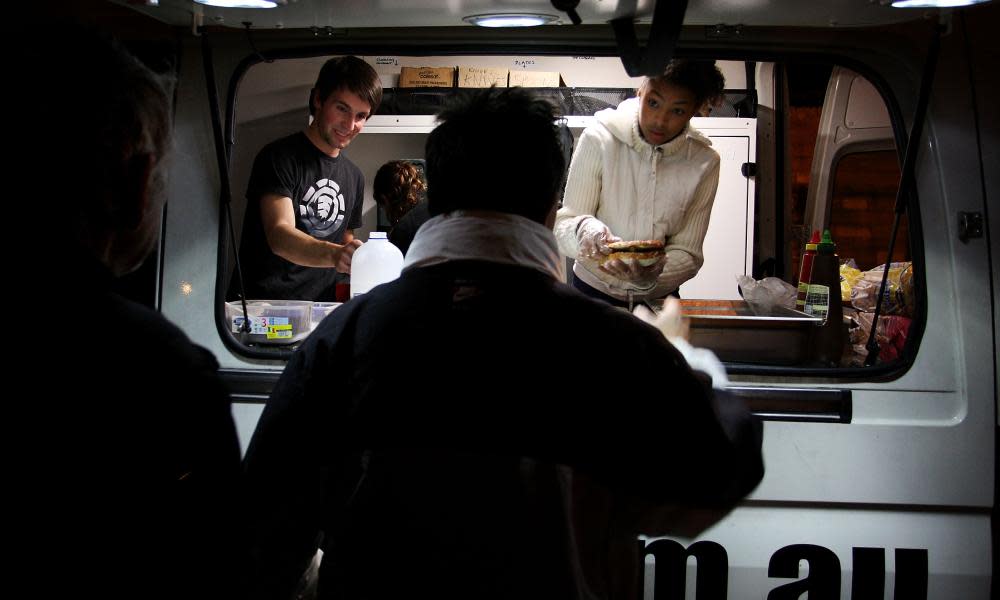‘It’s a devastating area’: how Melbourne lost its last refuge for the vulnerable

The western suburbs were once Melbourne’s last bastion of affordability. A refuge for the city’s vulnerable, where the unemployed and lowest-paid could still put a roof over their head.
Now, each morning, lines of rough sleepers and the hidden homeless spill out the doors of local access centres, waiting to be triaged and linked with housing support.
Those in line play a cruel game of chance.
Help is prioritised to the worst crises but there are rarely enough beds or appointments with support providers to go around.
“If you can get through the whole line and everyone gets an appointment, that’s a good day,” one homelessness support worker said, speaking to the Guardian anonymously. “And that maybe happens once every two to three weeks.”
Hotels refuse to take clients when homelessness services call. Many real estate agents won’t touch applications from those on welfare and the wait for public housing can stretch out for years.
Often, support workers say they have little choice but to send people to the unstaffed, unregulated private rooming houses that have flourished in the area, run by unscrupulous landlords who allow drug use and violence to go unchecked.
Those who miss out simply come back tomorrow, to try their luck again.
Melbourne’s west stood out in an analysis by Guardian Australia of the most recent recent census homelessness data, which has been mapped to show trends across the country.
The census data – which also reveals spikes in homelessness for those aged 19-24 and 25-34 – shows significant increases in homelessness rates in Footscray, Sunshine and Laverton.
The forces driving homelessness in Melbourne’s west are not unique. But the situation begs a question that must be asked in all of Australia’s major cities.
Where do the poorest go when even the most affordable rents rise beyond their means, the social housing supply fails to keep up with demand and funding for crisis accommodation remains stagnant?
Across Australia, the census figures showed an overall increase of 4.6% in the rate of homelessness in the past five years.
There were about 116,000 people experiencing homelessness on census night, or about 50 for every 10,000 people. That was up from 102,439 in 2011.
One in four were aged between 20 and 30 years. About 70% of young people experiencing homelessness had originally left home to escape family violence.
Sarah Langmore is the coordinator of the Western Homelessness Network, which covers Melbourne’s west. She says the loss of rental affordability in the area is the main cause of the homelessness spike.
In the Wyndham area, the percentage of rental properties affordable to those on low incomes had fallen dramatically, from 56% in 2011 to 27% in 2017.
“It’s a devastating area to be working in,” Langmore said. “I spent two days at one of our access points interviewing consumers about their experiences. Two days of hearing the stories, I was just devastated [about] what’s happening to people when they can’t find housing.”
She spoke to a woman who fled domestic violence to a friend’s house, only to be told there was a minimum wait of two years for social housing.
Another man, a student, had his food stolen repeatedly while living in a private rooming house. It happened so frequently that he ran out of money and began to starve.
Others have simply fallen into a routine of homelessness and are struggling to find a way out.
Steven*, aged 26, has been couchsurfing and in rooming houses for years in the area around Sunshine. He left school at age of 15 for a mechanics course but experienced mental health and drug issues and could not hold the job. Violence at his home saw his parents take out an intervention order, he said, preventing him from going home.
“It’s not like I had to sleep on the street in the city,” he said. “I’ve always had a friend or something, a house I can go to, someone saying ‘You’re welcome’. The community is pretty willing to help.
“If I could get a job, I’d get a job. But you have to have a reliance on someone giving you the job and they have got to be able to rely on you.
“Once you fall out of touch with your friends you start to make your own pattern, I guess, hanging around with your friends again and your pattern either gets worse or it gets better, depending on who you hang around with.”
The Council to Homeless Persons said the increasing homelessness in Melbourne’s west had long been recognised by local support services. The council’s chief executive, Jenny Smith, said it was a consequence of private rental increases, a lack of social housing and sluggish wage growth.
“So people move further out to chase cheaper rent but just face fiercer competition from other low-income earners,” Smith said. “It’s a game of musical chairs and the poorest are left without a home.”
The vast majority of those experiencing homelessness remain hidden in the area. About 70% of clients surveyed by the North and Western Homelessness Networks said they had stayed with friends or family. The responses in the survey reveal disturbing stories about private rooming houses. One respondent said the landlord had threatened them with violence. Another said: “Unsafe for kids in Rooming House. Got robbed there.”
Langmore said the private rooming houses were of significant concern.
“We have hundreds of private rooming house landlords who are just completely exploiting people who get trapped,” she said. “They are so costly but often really poorly run and not safe.”

 Yahoo News
Yahoo News 
